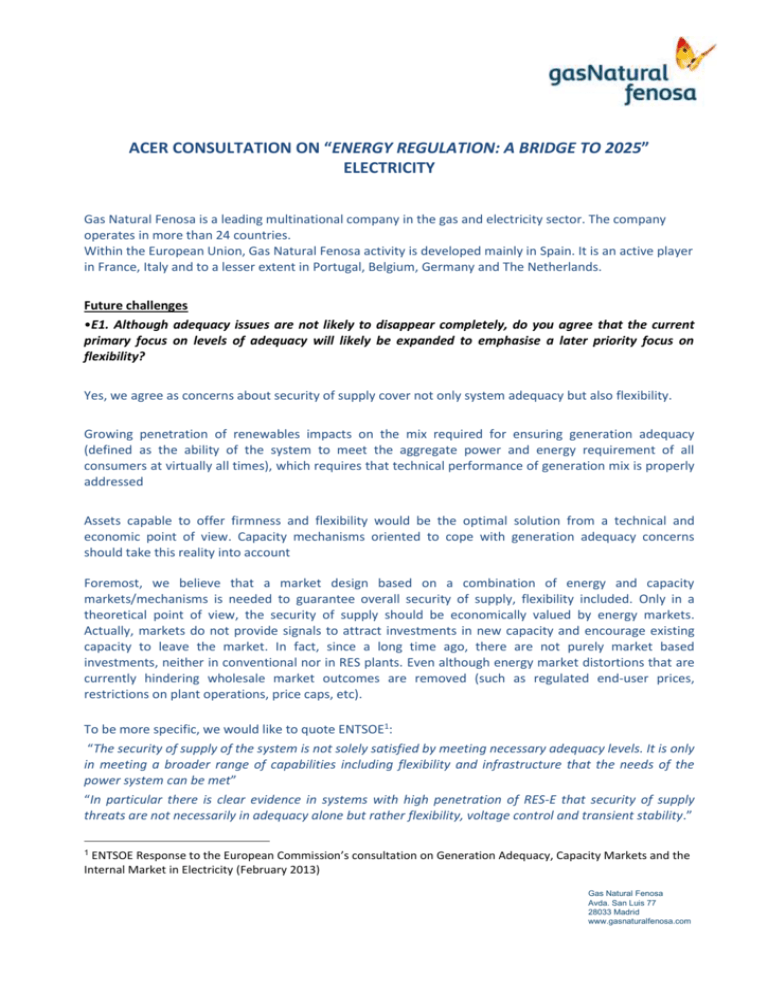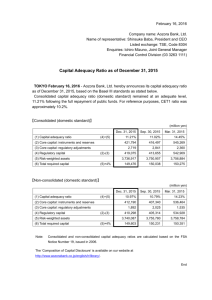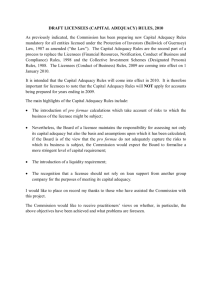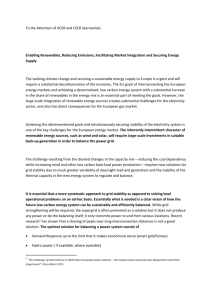Gas Natural Fenosa response - Document 2
advertisement

ACER CONSULTATION ON “ENERGY REGULATION: A BRIDGE TO 2025” ELECTRICITY Gas Natural Fenosa is a leading multinational company in the gas and electricity sector. The company operates in more than 24 countries. Within the European Union, Gas Natural Fenosa activity is developed mainly in Spain. It is an active player in France, Italy and to a lesser extent in Portugal, Belgium, Germany and The Netherlands. Future challenges •E1. Although adequacy issues are not likely to disappear completely, do you agree that the current primary focus on levels of adequacy will likely be expanded to emphasise a later priority focus on flexibility? Yes, we agree as concerns about security of supply cover not only system adequacy but also flexibility. Growing penetration of renewables impacts on the mix required for ensuring generation adequacy (defined as the ability of the system to meet the aggregate power and energy requirement of all consumers at virtually all times), which requires that technical performance of generation mix is properly addressed Assets capable to offer firmness and flexibility would be the optimal solution from a technical and economic point of view. Capacity mechanisms oriented to cope with generation adequacy concerns should take this reality into account Foremost, we believe that a market design based on a combination of energy and capacity markets/mechanisms is needed to guarantee overall security of supply, flexibility included. Only in a theoretical point of view, the security of supply should be economically valued by energy markets. Actually, markets do not provide signals to attract investments in new capacity and encourage existing capacity to leave the market. In fact, since a long time ago, there are not purely market based investments, neither in conventional nor in RES plants. Even although energy market distortions that are currently hindering wholesale market outcomes are removed (such as regulated end-user prices, restrictions on plant operations, price caps, etc). To be more specific, we would like to quote ENTSOE1: “The security of supply of the system is not solely satisfied by meeting necessary adequacy levels. It is only in meeting a broader range of capabilities including flexibility and infrastructure that the needs of the power system can be met” “In particular there is clear evidence in systems with high penetration of RES-E that security of supply threats are not necessarily in adequacy alone but rather flexibility, voltage control and transient stability.” 1 ENTSOE Response to the European Commission’s consultation on Generation Adequacy, Capacity Markets and the Internal Market in Electricity (February 2013) Gas Natural Fenosa Avda. San Luis 77 28033 Madrid www.gasnaturalfenosa.com “Capacity Mechanisms (CM) (…) should address not only adequacy, but also emerging flexibility issues and may be locationally dependent, particularly for weakly interconnected systems or regions” The Flexibility challenge • E2. Should we seek to further define, measure and develop flexibility in addition to the initiatives that are underway? If so, how could this best be done and in which market time periods? If ‘flexibility’ becomes an active that deserves being economically valued, attention should be paid because different technologies (both on the supply2 and demand side3) may not offer the same product: real, firm and reliable enough capacity. Reliable can mean short-responsiveness, predictable or/and during a sufficient period of time. • E3. What are the market-based routes for flexible ‘tools’ to participate? In principle, day ahead, intraday and balancing market should value flexibility. The choice of the best compatible technology should be then left to the market. Some pre-requisites are needed. First, there should not be any regulated prices. Second, data availability to the relevant market player must be assured, and third, demand must have the technical and commercial possibility to react on prices. Nevertheless, Energy and balancing markets aren’t actually able to deliver the necessary price signals for new flexible and firm resources and to prevent existing capacity to leave the system: : Investment decisions cannot be carried out based because of a supposedly and indeterminate participation in balancing markets to obtain an adequate return. Balancing markets provide, by definition, volatile prices and volumes. A decision of investment mainly based in returns on these markets is not realistic. • E4. What measures may be required to ensure that the market receives the most appropriate signal for the value of flexibility? The full implementation of effective day ahead, intraday, balancing and ancillary services market in which prices should be allowed to rise above short run marginal cost, enabling flexible generators to cover part of their fixed costs. In any case is important authorities do not intervene in the market and accept price signals such as price spikes and price volatility We would like NRAs could analyse whether existing market balancing designs can actually give the efficient price signals or whether these are sufficient to provide the right investment signals. Balancing markets provide, by definition, volatile prices and volumes. A decision of investment mainly based in these markets is unthinkable. 2 For instance, in Spain, depending on the weather conditions, hydro cannot provide the same generating capacity year on year. In a dry year, its contribution can decrease a lot, as facilities are not able to produce at a maximum level. We consider that their remuneration should be adjusted according to the reliability they can provide. So, in general, considering that what is being rewarded is the availability of capacity, different technologies should demonstrate a certain degree of reliability and firmness 3 How long is load shedding or demand response a solution if the problem persists? 2 As we believe that energy markets aren’t able to deliver the necessary price signals, the development of capacity remuneration mechanisms is needed. Obviously, Regulators should design capacity mechanisms not only looking for a certain adequacy target but also flexible technologies. Capacity mechanisms have to be implemented for availability of new and existing flexible power plants, including testing of power plants to ensure their real availability. • E5. Do you think that other, for example institutional arrangements should be considered? Is greater TSO and DSO coordination required? If so, what should NRAs do to facilitate this? The ENTSO-E reports seem to conclude that generation adequacy is fulfilled according to their TSOs perspective. However, according to the point of view of market players, there are aspects that they could not have taken into account. TSO’s position tend to focus mainly on international transmission lines and cross-border trading to provide available capacity/supply but there also are other aspects like needs in flexible generation availability or demand side response that should be taken into account. All resources are currently necessary and the ENTSO-E forecast should also take into account both resources, but flexible generation capacity is not sufficiently detailed in ENTSO-E Outlook. Other actions that can be done Provide market based routes for flexible technologies to effectively participate in national and cross-border intraday and balancing markets; Encourage greater cooperation between TSOs to improve real time operational security; Continue to improve the planning and implementation of adequate network infrastructures, including further interconnection between member states. The Smarter Grids and smarter demand • E6. How should regulators facilitate demand side participation (including demand side response and electricity storage)? Demand side participation depends on transparent, cost reflective and reliable price signals. The elimination of tariff cross-subsidies and the deregulation of energy tariffs are both necessary to not hamper the effective use of such measures. Aggregation of demand should be done by energy suppliers -as they can participate in the same markets (e.g. intraday and balancing markets) under the same requirements - should be subject to market competition and customer acceptation should be required. Otherwise, the relative weight of pure energy costs in the bill should become more reduced in the future due to the increase of fixed costs (mainly due to TPA and energy policies cost). Therefore we encourage ACER to dig into the real interest of most of the domestic customers to obtain load-shedding discounts once they would assess the scarce impact of this on the bill. ACER should assess if maybe only most economically vulnerable customers could be inclined to use these services. 3 • E7. How can NRA support, or incentivize TSOs and DSOs to invest in ‘smart networks’. What actions are needed, in particular from regulators, to promote more active distribution networks? Do we sufficiently reward avoiding ‘dumb’ investments? From a high level perspective, system services are needed, and these are based on the national regulatory frameworks. For instance, load shedding is one of these services which may be generally done with in-house Energy Management Systems activated by the commercial player that provides them (i.e. the aggregator). Those market players are the ones who have the contract with DSOs and TSO, maybe arranged trough a kind of flexibility pool. Cooperation between TSO and DSOs is very important: if bottlenecks or any other problem appear, both have to be coordinated, considering that the same system service can be used by both sides. TSO is responsible of its network and the coordination of system users connected to transmission. DSOs are also responsible of their networks and the coordination of system users connected to distribution. The flexibility pool could be the place for coordination because the action of one of the operators can go against the responsibility of the other one. The current setting of such a platform may provide visibility and coordination tools to prevent that problem. Encouraging competition • E8. How should NRAs influence the competition debate, for example on support schemes, regulated tariffs, capacity remuneration mechanisms, etc? The European Commission has recently proposed many actions of priority interest to alleviate the concerns on generation adequacy, such as phasing out of distorting regulated prices in both wholesale and retail markets, or incentivizing RES to participate in the energy markets, or the expansion of interconnection capacity. However, most of these actions can not be quickly implemented, and many operators remain facing losses. We miss a more realistic view of current capacity remuneration mechanism taking into account the present genuine concerns in many countries. Among other urgent measures, regulated retail prices should be eliminated as they act as a barrier to effective competition. As recognized by the European Council, measures to support vulnerable consumers should not undermine the correct functioning of the electricity market, including price signals for demand (EC 22-May-2013 EUCO 71/1/13 • E9. To what extent should the relationship between competition in electricity and gas markets influence regulators’ activities? Could regulatory action on the gas market, help solving the flexibility problem of the electricity market? The increasing penetration of intermittent renewable energy sources introduces new requirements of balancing supply and demand, mainly because of their unpredictability and their lack of connection with power demand patterns. The impact of this requirement for flexibility puts pressure in the gas markets and their infrastructure. The reduction in the number of operating hours of gas based power plants causes a more intermittent use and congestion of gas grid infrastructure. It also has an impact on the cost recovery of other gas 4 infrastructures (such as storage) which are necessary for the delivery to power plants at peak times. Additionnally, it imposes an increase of TPA born by other gas end users, reducing the competitiveness of natural gas. An impact assessment of the regulatory interventions on the electricity market should consider their effect on the gas system. Other wise, when existing, restrictions on gas plant offers should be avoided and removed. For example if there are technically unjustified re-nomination lead-times on the gas system, yet limit the offering of flexible generation from power stations • E10. How should regulators remove barriers to entry for new supply sources? We are afraid of ACER could put many efforts to draw extensive regulation thinking on the potential of prosumers but the reality could be broadly different. For instance, considered that the variable part of energy bills is more and more reduced due to other costs of energy policy (e.g RES subsidies) the economic benefits of demand response would encourage customers less and less; or there is a customer preference for flat fixed energy tariffs not subject to daily/hourly prices; or considered that artificially low regulated prices hamper competition; or even that distribution grids in isolated areas could suffer from overdimension to evacuate big amount of RES distributed generation (and, so, increasing third party access tariffs). Bad tariff structures which tend to recover many fixed costs (mainly network costs) into variable components should be amended. This practice is extremely detrimental in terms of information (grid and others costs which are recovered via a variable term are associated to a bad functioning of energy markets, especially if they are increasing). Even worst, with those tariff structures, grid costs of apartments and second homes are not fully recovered neither via the annual fixed component (which only covers part of the grid cost incurred) nor the variable costs (by definition, these homes are not occupied full time, so that the variable cost recovery per point of connection is less than in a permanent home). In countries with many second residences such as Spain, these structures penalize those consumers with lower rents who subsidize the network costs of others. • E11. What actions, identified in these papers, should regulators prioritise? The need to avoid market distortions within the European energy market should be a main objective. The integration of wholesale electricity and gas markets to the extent possible should be prioritised. More integrated balancing markets and better functioning intraday markets can contribute to this. Therefore ACER should focus on the development of the Network Codes to help deliver the benefits from integrated and liberalised markets. 5







